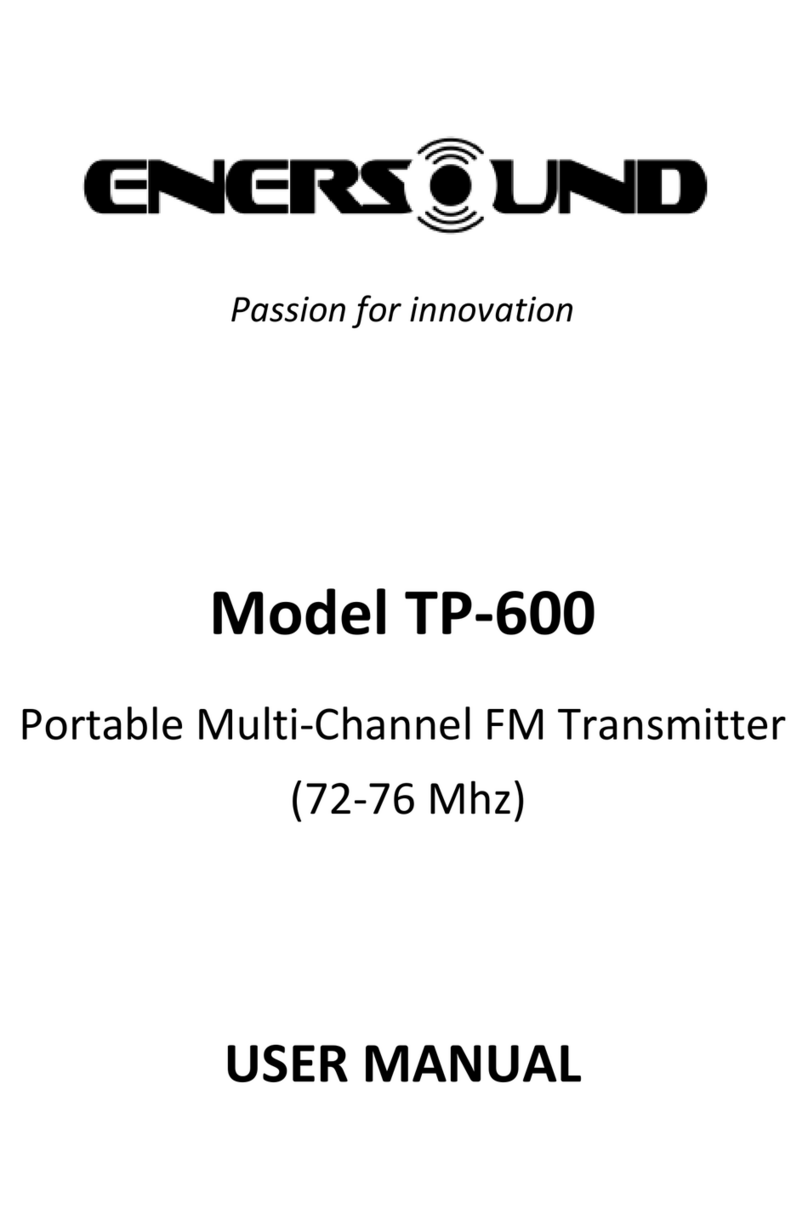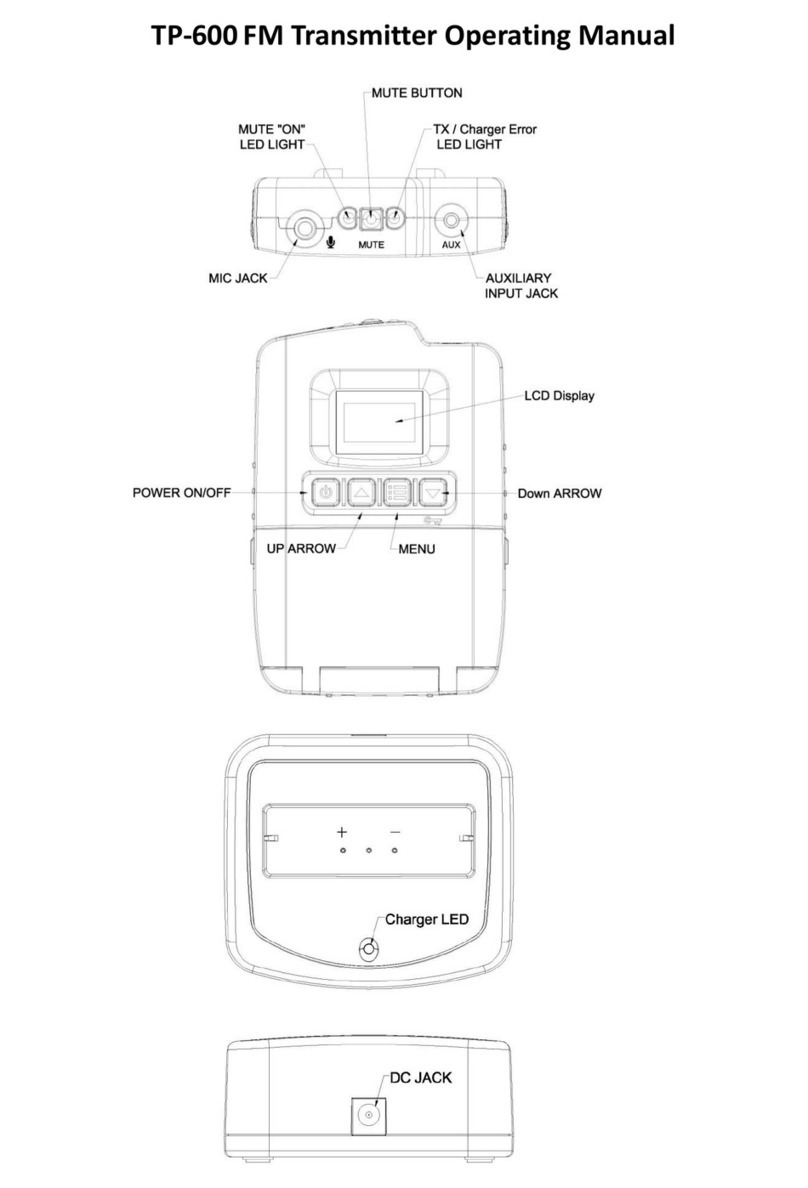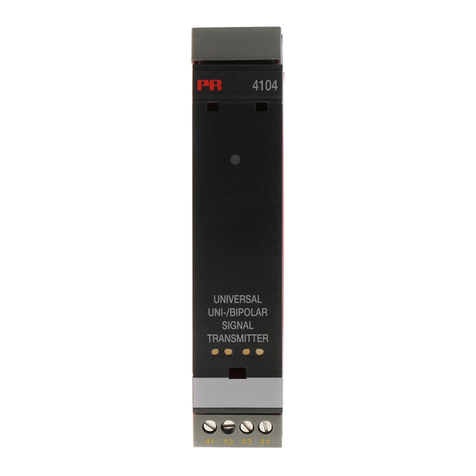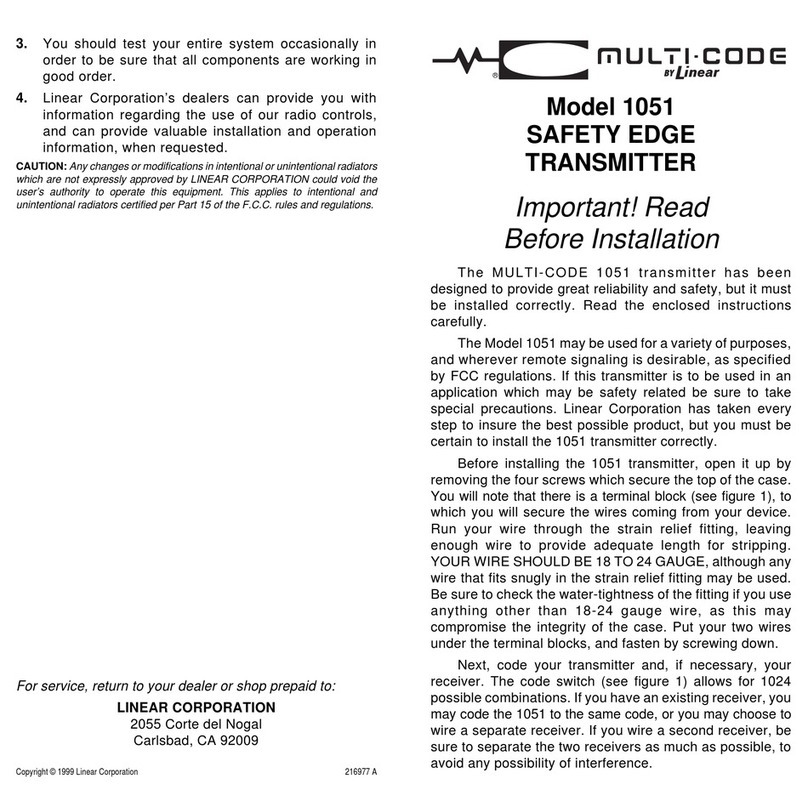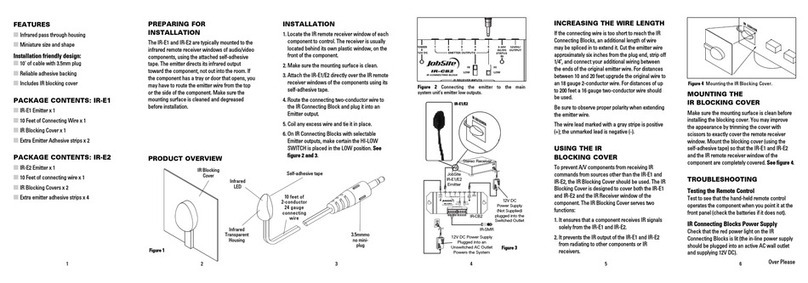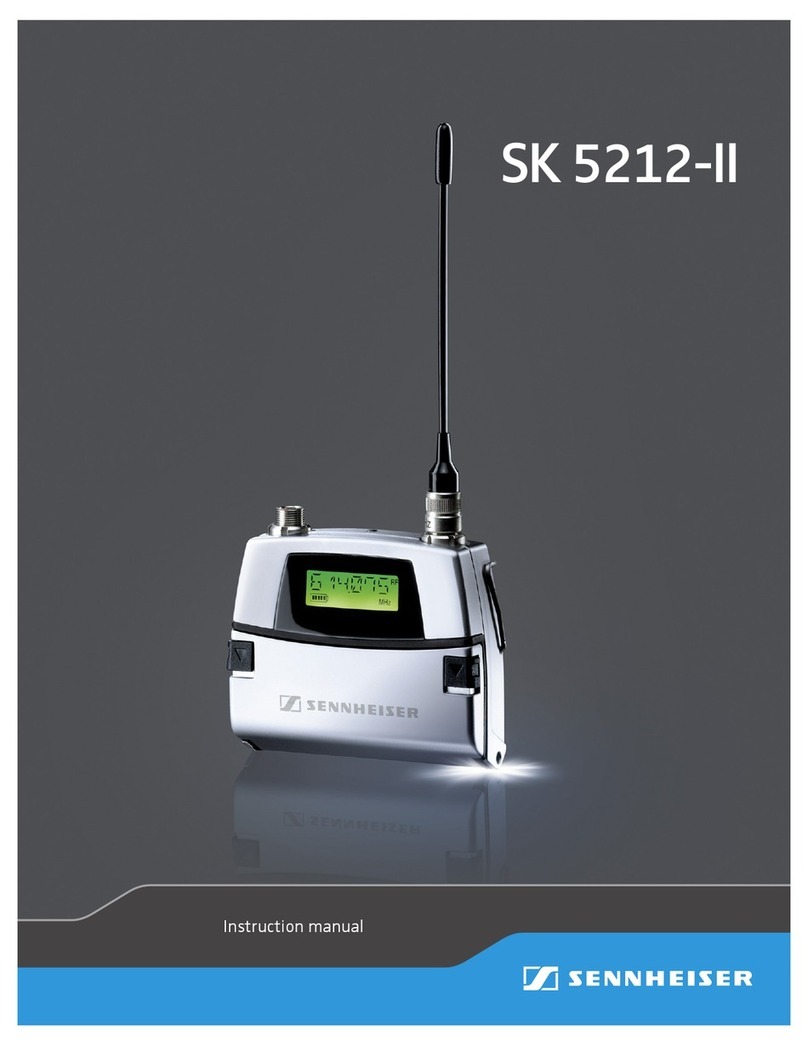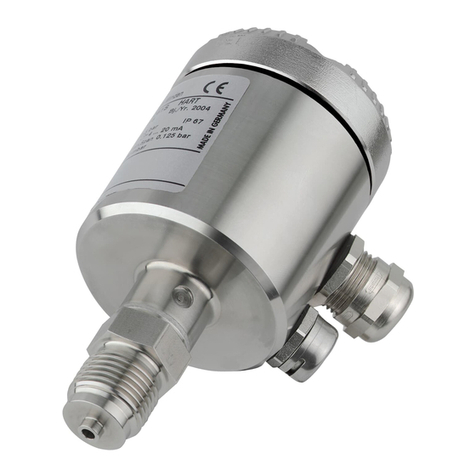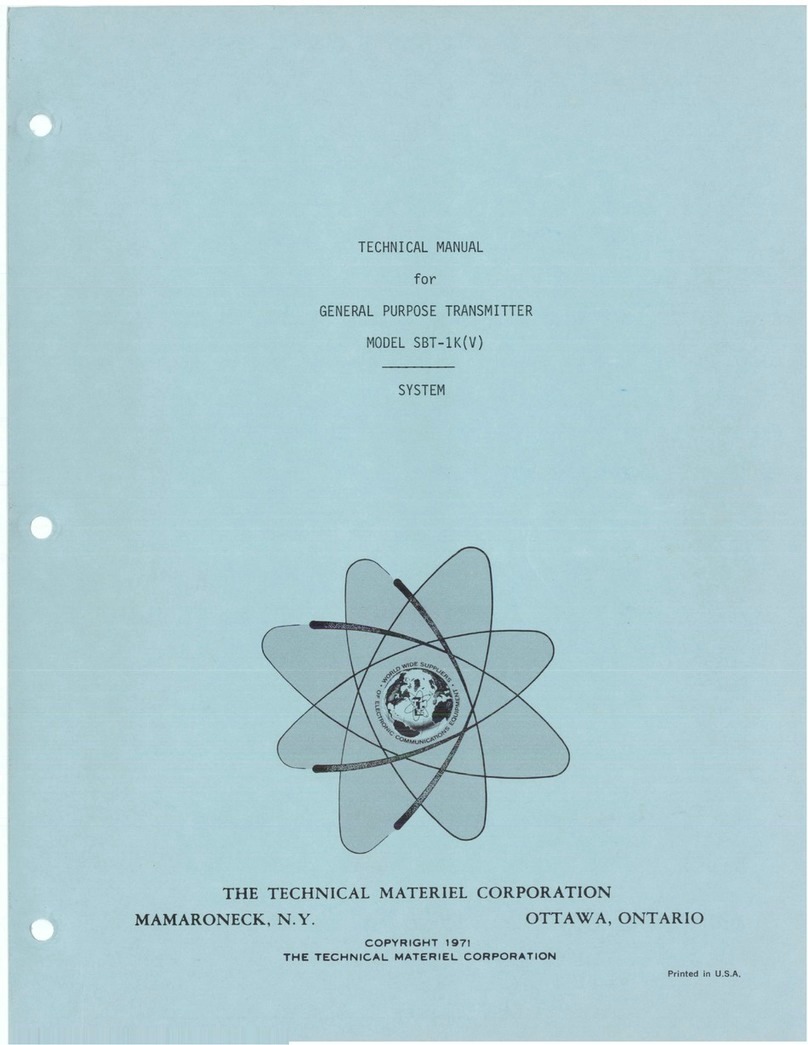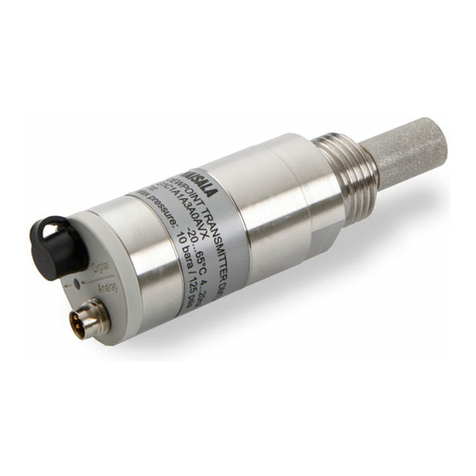Enersound T-500-4 User manual

1
USER MANUAL
Passion for innovation
Model: T-500
Version: 4
SKU: T-500-4
4 Channel FM Transmitter
(72-76 Mhz)

2
T-500-4 Table of Contents_________________________________________
About this Manual ………………………………………………………………….. 3
Package Contents ……………………………………………………………….….. 3
System Overview ……………………………………………………………….…... 3
Quick reference: Controls, displays and connectors ……….………. 4 - 5
Front Panel ………………………………………………………………………….. 4
Rear Panel ………………………………………………………………….………… 5
Set-up Instructions …………………………………………………………………. 6 - 11
General Set-Up Instructions ………………………………………………… 6 - 8
Application Notes ……………………………………………………………….. 9 - 11
a) For direct language interpretation ………………………………. 9 - 10
b) For language interpretation with interpreter console …. 10-11
Menu Setting Instructions ………………………………………………………. 11-13
Safety Information ………………………………………………..……………….. 13-14
Trouble Shooting …………………………………..……………………………….. 14-15
FCC & IC Statements ………………………………………………………………. 16
Warranty Statement ………………………………………………………………. 17
Optional Accessories ……………………………………………………….……... 18
Frequency Chart …………………………………………………………………….. 18
Technical Specifications ………………………………………………………….. 19

3
About this Manual
Read this user manual carefully before installing and operating your T-500-4 FM
transmitter. Use the product only as described to avoid accidental injury, damage or
hearing impairment. Also, read safety warnings carefully. Keep this manual for
future reference. If you give this product to someone else, remember to include this
manual.
Package Contents
(1) T-500-4 FM 4-channel transmitter (72-76 MHz)
(1) ANT-500 helical antenna
(1) PS-500 power supply with AC cord
(1) User manual
System Overview
Thank you for choosing the Enersound T-500-4 FM 4-channel transmitter. This
professional transmitter is designed for assistive listening and language
interpretation. It wirelessly broadcasts a speaker’s voice, music or any audio signal
up to 1000 ft. (305 m). The audience can use the optional R-100 FM receivers, R-120
FM multichannel receiver or any other compatible FM receiver operating on the 72-
76 MHz frequency to pick up the broadcast. The T-500-4 transmitter features 3 main
audio inputs that allow the direct connection of virtually any analog audio source,
including a 3.5 mm jack for headset microphones, an XLR & ¼ inch combination jack
with a selector for dynamic microphones, condenser microphones or line-level
signals, and a RCA line auxiliary input. It also has a recording output and a 3.5 mm
monitor headphone jack.
For language interpretation, it has a unique integrated interpreter monitor function.
This feature allows interpreters to select an external incoming audio source and
utilize a headset with microphone to listen to the source language without the need
of an interpreter console or external headphone amplifier. Through the
headphones’ volume control, interpreters can set the desired incoming audio level
and the [MUTE] button allows them to momentarily silence their microphone for
coughing or sneezing. For more advanced interpreting functions, it can also be
utilized with the Enersound IC-12 multi-channel interpreter console or with any
other interpretation platform with analog audio outputs.
Its LCD display allows to easily program the various useful functions, such as test
tone, RF power level, display mode (frequencies or channel numbers), and channel
lock.

4
Quick Reference: Controls, Displays and Connectors
Front panel
(1) POWER button: Press & hold for 5 seconds to turn on/ off device.
(2) Power indicator
(3) Front microphone mute button: Press to mute/unmute front microphone.
(4) Mute indicator light
(5) Mic input, 3.5mm jack
(6) Main volume control: Adjusts audio output volume.
(7) Headphones volume control
(8) Up button: Changes channel/frequency up. During setting mode, press to
modify selection.
(9) Menu button: Press & hold for 6 seconds to access setting menu.
(10) Down & lock button: Changes channel/frequency down. Press & hold for 5
seconds to lock/ unlock channel/frequency. During setting mode, press to
modify selection.
(11) Headphones output, 3.5mm jack
(12) Internal/external monitor source selection switch: Set to EXT for language
interpretation applications to monitor an external audio source (speech to be
translated). Set to INT to monitor the broadcasted audio.
(13) Internal selection indicator
(14) External selection indicator
(15) LCD screen
(16) (17) Audio level indicators
(18) Audio peak indicator

5
Rear panel
(19) Remote antenna connector
Used when top mounted antenna is not convenient, for example when rack
mounting. Use only ONE antenna connector at a time.
(20) External monitor Input
Used in language interpretation applications. The audio source to be translated
should be connected here so the interpreter can listen to the source language.
This signal will NOT be broadcasted to FM receivers.
(21) Recording output
This RCA jack contains a mix of Input 1, Input 2 and front 3.5 mm microphone.
(22) Input 2, RCA jack
Connects unbalanced audio signals to be broadcasted.
(23) Gain
Adjusts Input 1, Input 2 and front mic gain level.
(24) Input 1 mode selector
Selects line level, microphone level, or microphone with 12V phantom power for
condenser mics.
(25) Input 1
Accepts balanced or unbalanced connection of a microphone or line level input. This
combination jack accepts either XLR or ¼” plugs.
(26) Power supply jack
Used with the included PS-500 15V power supply.

6
Set-up Instructions
General Set-up Instructions:
Unpack the transmitter
Remove outer packaging and plastic cover. Inspect for physical damage and
immediately report any issues.
Position the unit
Position the transmitter near the audio source (sound system, mixer,
interpreter desk, etc.), away from metallic objects that might interfere with the
antenna.
Connect the antenna
For tabletop use, screw in the antenna connector onto the transmitter top
antenna connector. Alternatively, an optional remote antenna can be used.
Do not use two antennas at the same time.
Rack mount the unit (optional)
The transmitter can be rack mounted, if necessary, in a 19’’ rack using the
optional rack mount kits: single-unit RM-501 or double-unit RM-502.
Dual rack mount RM-502 for 2 T-500 transmitters
NOTE: If rack mounting, do not use the top antenna connector; you will need to use
the rear connection antenna with a 90 degree adapter AD-590 or use the optional
rack-mount antenna kit RAK-500 available for purchase.
If needed, you may also use a remote antenna ANT-501.
Only use original Enersound antennas. Check with your authorized Enersound dealer
or visit www.enersound.com to view available accessories.
Power the Unit
Plug the power supply into the power connector on the rear panel, then connect
the power supply into an outlet. Only use the Enersound approved power
supply. (The PS-500 is an auto switching power supply that can work with
voltages between 100 and 240 V, 50/ 60 Hz.)
Press and hold the [POWER] button for 5 seconds to turn on the unit.

7
Select Channel
Select the desired channel using the [UP] or [DOWN] buttonson the front panel.
If the unit is locked, unlock it by pressing and holding the [DOWN] button for 5
seconds.
Depending on the display mode, the screen will show either the channel
number (channel mode) or the frequency (frequency mode).
If necessary, after selecting the desired channel, you can lock it by pressing and
holding the [DOWN] button for 5 seconds.
Note: Make sure the FM receivers are tuned to the same frequency as the T-
500-4 transmitter. If you are using Enersound R-120 or R-100 receivers, the
channels will correspond to the channels on the T-500-4 transmitter. If you are
using compatible receivers of other brands, frequencies may differ.
Consequently, we recommend setting the Enersound T-500-4 transmitter to
Frequency Display mode.
To set the transmitter on Frequency Display mode, press and hold the [MENU]
button for 6 seconds to access the Setting menu. See page 12 for more details.
Enersound T-500-4 Frequency Chart
CH 1
72.1 MHz
CH 2
72.5 MHz
CH 3
72.9 MHz
CH 4
75.7 MHz
Connect Audio Inputs
The T-500-4 has several audio inputs:
Rear Panel:
Input 1: For balanced or unbalanced connections using either an XLR or 1/4”
phono connector. Ideal for connecting audio mixers, dynamic microphones
or 12V condenser microphones.
Plug your balanced or unbalanced audio source into Input 1. Use the
following diagram.

8
Note: To connect stereo signals use a simple resistive mixer as shown above
utilizing two 4.7KΩresistors available at a local electronic components store.
Input 2: An RCA auxiliary line level input.
External Monitor Input: An RCA line level input for simultaneous
interpretation applications that allows the interpreter to monitor the source
language. This audio signal will only be heard on the interpreter’s
headphones connected to the headphone jack on the front panel with
monitor selector set on EXT (External).
Front Panel:
3.5 mm microphone Input: Ideal for headband and headset microphones
with 3.5 mm connectors such as Enersound MIC-200, MIC-300, LAV-100
and interpreter headsets.
Connect the desired audio source(s) to one or more audio input connections. If using
input 1, select the appropriate audio setting (line, MIC or condenser MIC with 15V
phantom power).
Warning: 70 volt or any other speaker signals cannot be connected to
the T-500 transmitter. This may cause damage to your system.
For usage in direct language interpretation see explanation below.
Set the Volume
Listen with an FM receiver such as Enersound R-120 , R-100 or other compatible
receiver tuned in the same frequency or channel and adjust the transmitter’s main
volume control located in the front panel to the desired level.
If necessary, adjust the gain control on the transmitter’s rear panel. If unsure, turn
the gain control clockwise to the maximum level or a little bit less.

9
Application Notes:
a) Direct language interpretation: In cases where one-way interpretation is
required (source language into target language ONLY), you may take
advantage of the T-500-4 transmitter’s internal, integrated monitoring
function. For example, in a house of worship where the preacher speaks in
English and part of the congregation only understands Spanish. The
congregation has a passive role listening to the preacher’s sermon through
the interpreter’s voice. Up to four T-500-4 transmitters can simultaneously
be used in the same room to broadcast up to 4 different languages.
In this situation, we recommend using either, a headband microphone and
a headphone for the interpreter, or a combined interpreter headset with
microphone.
In either case:
Connect the 3.5 mm microphone plug onto the 3.5 mm front microphone
input on the transmitter.
Connect the 3.5 mm interpreter headphone plug onto the 3.5 mm front
headphones jack.
If available, connect the audio feed from the PA system (sound system)
onto the RCA external monitor input located on the transmitter rear panel.
Caution: Lower the monitor volume counterclockwise to the minimum
level before connecting the audio feed to avoid physical hearing damage.
Set the monitor source selection switch in the EXT (External) position. This
switch is located on the front panel.
Set the desired monitor volume to a comfortable level for the interpreter.
Set the main volume level: Speak through the interpreter’s microphone and
listen with an FM receiver, such as Enersound R-120, R-100 or other
compatible receiver tuned in the same frequency or channel, and adjust
the transmitter’s main volume control located in the front panel to the
desired level.
Note: See wiring diagram on the next page.

10
Direct Language Interpretation Audio Wiring Diagram:
b) Language interpretation with external interpreter console: In cases where two-
way interpretation is required (interpretation from source language into target
language and vice-versa), external interpreting consoles may be needed. For
example, a bilingual or multilingual conference where the floor language changes
due to panelists speaking different languages or the audience interacting with
panelists or presenter during question and answer sessions. In these cases, it is
recommended to assign a channel to each language. See below an example using
the T-500-4 transmitter with Enersound IC-12 interpreter consoles for three
foreign languages, plus main language.
Note: See wiring diagram on the next page.

11
Language Interpretation with External Interpreter Console: Wiring Diagram:
Menu Setting Instructions:
Press & hold the [MENU] button for 6 seconds to access the Menu. The LCD
display will start blinking and the first option TONE will be shown. To navigate
through different menu options, press the [MENU] button.
Test Tone: When TONE is blinking, you can turn the tone ON or OFF by pressing
the [UP]/ [DOWN] buttons. When TONE is activated (ON), the transmitter
broadcasts a test tone to help test receivers when no audio source is available.
After testing procedure, the tone should be deactivated (OFF).

12
To exit the menu, wait for 10 seconds and the LCD screen will stop blinking. You can
also exit the menu by pressing the [MENU] button several times to navigate through
the options until you reach EXIT and press [MENU] one more time.
RF Power: While in Menu, press the [MENU} button to navigate through the options
until you reach POWER. When POWER is blinking, press the [UP]/ [DOWN] buttons
to change the settings to LOW or HIGH. The level of transmitted RF power needed
depends on your application. If you are operating several transmitters in the same
room, it is recommended to set the transmitters output power to LOW (L) to reduce
the possibility of interference. To exit the menu wait for 10 seconds.
Channel/ Frequency Mode:
You can choose the screen to show either channel numbers or frequencies. If you
are using Enersound R-120, R-100 or other compatible Enersound receivers, the
receiver channels will correspond to the T-500 transmitter channels. If you are using
compatible receivers of other brands, frequencies may differ. Consequently, when
using receivers from other manufacturers, we recommend setting the Enersound T-
500 transmitter to Frequency Display mode.
While in Menu, press the [MENU} button to navigate through the options until you
reach CHANNEL/ FREQ. When CHANNEL or FREQ is blinking, press the [UP]/ [DOWN]
buttons to change the settings to Channel Display Mode (CHANNEL) or Frequency
Display Mode (FREQ). To exit the menu wait for 10 seconds.
FM Deviation: This option allows you to select the FM transmitter’s frequency
deviation between +/- 75 KHz (W) and +/- 25 KHz (N).
While in Menu, press the [MENU} button to navigate through the options until you
reach BAND. When BAND is blinking, press the [UP]/ [DOWN] buttons to change the
settings to wide-band +/-75 KHz (W) or narrow-band +/- 25 KHz (N). To exit the menu
wait for 10 seconds.

13
Note: If you are using Enersound R-120, or R-100 FM receivers, choose the +/- 75
KHz (W) option. Most receivers of other brands also work on +/- 75 KHz. If you are
using FM receivers of other brands check the receivers’ specs for FM deviation or
contact the manufacturer.
Caution! If you are using a receiver with FM deviation +/- 25 KHz with a transmitter
set to +/- 75 KHz, you may experience over modulation, loud volume and distortion.
In contrast, if you are using a receiver with FM deviation +/-75 KHz with a transmitter
set to +/- 25 KHz, you may experience low audio volume on the receivers.
Exit: While in Menu, press the [MENU} button to navigate through the options until
you reach the fifth option EXIT and press the [MENU] button one more time to exit
the menu.
Safety Information:
HAZARD! Pacemaker Safety
Before using this transmitter and/ or receivers with a pacemaker or another
medical device, consult your physician or the manufacturer of your pacemaker
or another medical device.
If you have a pacemaker or another medical device, make sure that you are
using this transmitter and/or receivers in accordance with safety guidelines
established by your physician or the pacemaker manufacturer.
WARNING! Damage to your Health
Using earphones or headphones at a loud volume or over a prolonged period of
time can lead to permanent hearing damage. To protect your hearing and
others:
a) Turn down the volume before putting on the earphones or headphones.
b) Adjust the volume at the minimum comfortable level.
c) If feedback (a squealing or howling noise) occurs, turn down the
headphone volume, and move the microphone away from the receiver’s
headphones.

14
Other Safety Considerations
Do not leave the device in places with high temperatures or high humidity.
Do not handle the power cord with wet hands.
Keep this device away from fire and heat sources.
Keep this product, accessories and its packaging out of the reach of children.
Plastic bags, packing material, electrical cords and other accessories may cause
choking, suffocation and/or electrocution!
Do not open the unit. There are no user serviceable parts inside.
Reduce the volume to its lowest setting before use.
To clean, be sure to first switch off and unplug the unit from the power outlet,
then wipe with a dry cloth. When extremely dirty, use a soft cloth dampened in
neutral detergent. Never use benzene, thinner or chemically-treated towels,
which may damage the product’s finish.
Troubleshooting
The transmitter will not power.
Verify that the PS-500 power supply is connected to a working power
source and to the transmitter.
Make sure you are pressing and holding the [POWER] button for 5 seconds.
There is no audio on the transmitter’s headphones output.
If you are using the monitor headphones for language interpretation, make
sure the monitor selector is set to EXT (External audio).
Verify that the external audio signal is connected to the external audio
input jack.
Verify that there is a signal coming from your audio source.
If you are using the headphones to monitor the broadcasted audio, make
sure the monitor selector is in the INT (Internal) position.
There is no audio or the audio is low on the receivers.
Make sure that the main volume is turned up and that your audio source is
properly connected. If using Input 1, the mode selector switch should be in
the correct position. For example: if you are using the output of a mixer,
the switch should be in the LINE position. If using a dynamic microphone,
the switch should be in MIC and if using a 12 V condenser microphone, the
switch should be in MIC PH-PWR.
If the audio level is still low, make sure that the gain knob on the rear panel
is turned up.
If using the front microphone jack, make sure that the mute function is off
and that you are using a compatible microphone in working condition.

15
There is noise or distortion in the audio.
Verify if the audio input level is too high that overloads the input. Adjust
the gain if necessary. If using input 1, make sure you are using the correct
mode selector switch.
Check to see if there is noise or ground loops in the audio source.
If using receivers of other brands, make sure the frequency deviation BAND
setting on the transmitter is compatible with the receivers (N: 25 KHz or W:
75 KHz). Please refer to FM Deviation above under Menu Setting
Instructions.
Receivers cannot pick up the signal.
Make sure that the transmitter and the receivers are turned on.
Check to make sure the receivers and the transmitter are using the same
frequency. If using another brand of receiver, check the frequency chart
corresponding to the receivers’ channels and the frequency on both
receivers and transmitter must match; channel numbers may not necessary
be the same.
Ensure the antenna on the transmitter has been properly connected.
There is insufficient range.
Verify that your receivers are working properly.
Make sure the antenna is the correct one for your unit and is adequately
attached to either the top of the T-500-4 transmitter or to the back of the
unit if you are using a remote antenna. Never use two antennas at the same
time.
If using a remote antenna, keep coaxial cable from transmitter to antenna
as short as possible.
Make sure the transmitting antenna is oriented vertically.
The antenna should be placed as high as possible and free of obstacles.
Avoid placing it inside metal enclosures. Avoid obstacles between the
listening area and the antenna that may affect the signal strength, like
partitions,metal objects, dense materials, studs, pipes, heating or AC ducts,
metal grids or concrete.
Set the transmitter to high power.
Try using a different channel/ frequency since a strong interfering signal
may exist.

16
FCC Statement
In the US, the FCC limits the use of this device to assistive listening and simultaneous
interpretation. This transmitter cannot be used in all countries. Check with your
government’s radio regulations for 72-76 MHz operation.
Any changes or modifications not expressly approved by the party responsible for
compliance could void the user's authority to operate the equipment.
This device complies with part 15 of the FCC Rules. Operation is subject to the
following two conditions:
(1) this device may not cause harmful interference, and
(2) this device must accept any interference received, including interference that
may cause undesired operation.
IC Statement
This device complies with Industry Canada license-exempt RSS standard(s).
Operation is subject to the following two conditions:
(1) this device may not cause interference, and
(2) this device must accept any interference, including interference that may cause
undesired operation of the device.
This radio transmitter (T-500) has been approved by Industry Canada to operate
with the antenna types listed below with the maximum permissible gain and
required antenna impedance for each antenna type indicated. Antenna types not
included in this list, having a gain greater than the maximum gain indicated for that
type, are strictly prohibited for use with this device.
The device is in compliance with RF field strength limits; users can obtain Canadian
information on RF exposure and compliance.
Le présent appareil est conforme aux CNR d'Industrie Canada applicables aux
appareils radio exempts de licence. L'exploitation est autorisée aux deux conditions
suivantes:
(1) l'appareil ne doit pas produire de brouillage, et
(2) l'utilisateur de l'appareil doit accepter tout brouillage radioélectrique subi, même
si le brouillage est susceptible d'en compromettre le fonctionnement
Le présent émetteur radio (T-500) a été approuvé par Industrie Canada pour
fonctionner avec les types d'antenne énumérés ci-dessous et ayant un gain
admisible maximal et l'impédance requise pour chaque type d'antenne. Les types
d'antenne non inclus dans cette liste, ou dont le gain est supérieur au gain maximal
indiqué, sont strictement interdits pour l'exploitation de l'émetteur.
Le présent appareil est conforme Après examen de ce matériel aux conformité aux
limites DAS et/ou aux limites d’intensité de champ RF, les utilisateurs peuvent sur
l’exposition aux radiofréquences et la conformité and compliance d’acquérir les
informations correspondantes

17
Limited Warranty Statement
Enersound warrants the T-500-4 mother board to be free from defects in
workmanship and material under normal use and conditions for 3 years from date
of purchase from an authorized dealer. All other T-500-4 parts including
connectors, screen and moving parts, are warranted for one year from the date of
purchase. If the product is determined to be defective, Enersound will repair or
replace it, at its discretion, at no charge. Customer must pay for shipping. This
warranty is void if damage occurred because of misuse or if the product has been
repaired or modified by anyone other than a factory-authorized service technician.
Warranty does not cover normal wear and tear on the product or any other
physical damage unless the damage was the result of a manufacturing defect.
Damage due to water, corrosion, humidity, extreme temperature, chemicals, or
any other external factor is not covered under this warranty. Reimbursement for
your costs of removing and transporting the product for warranty service
evaluation or installation of any replacement product are not covered by this
warranty.
Enersound has no control over the conditions under which this product is used.
Therefore, the company disclaims all warranties not set forth above, both express
and implied, with respect to the T-500-4 transmitter, including but not limited to any
implied warranty of merchantability or fitness for a particular purpose. Enersound
products manufacturer, distributors and/or dealers shall not be liable to any person
or entity for any medical expenses or any direct, incidental or consequential
damages caused by any use, defect, failure or malfunction of the product, whether
a claim for such damages is based upon warranty, contract, tort or otherwise. The
sole remedy for any defect, failure or malfunction of the product is the replacement
of the product. No person has any authority to bind Enersound to any
representation or warranty with respect to the Enersound T-500-4 transmitter. This
warranty gives you specific legal rights, and you may also have other rights which
vary from state to state. Some states do not allow limitations on how long an implied
warranty lasts, and the exclusion or limitation of incidental or consequential
damages, so the above limitation may not apply to you. This warranty does not cover
products sold AS IS or WITH ALL FAULTS. For products sold outside the U.S., please
consult with your local dealer about special terms and conditions applicable in your
country. Proof of purchase in the form of a bill of sale, invoice number or receipted
invoice, which is evidence that the unit is within the warranty period, must be
presented to obtain warranty service. If you experience any issues with your T-500-
4 transmitter, send an email to support@enersound.com with your name, address,
phone number and a complete description of the problem. We will respond to you
as soon as possible and if it is necessary to return the product for service, your
Customer Service Representative will give you a Return Authorization Number (RAN)

18
and shipping instructions. For more information, visit www.enersound.com. You
may also call 1-305-731-2416 or our toll-free number 1-800-644-5090 within the
U.S.
T-500-4 Optional Accessories
To purchase accessories, contact your local dealer.
If you are unable to find a dealer in your area, contact us for more information:
Toll free: 1-800-644-5090
International: +1-305-731-2416
info@enersound.com
www.enersound.com
Enersound T-500-4 Frequency Chart
CH 1
72.1 MHz
CH 2
72.5 MHz
CH 3
72.9 MHz
CH 4
75.7 MHz
ANT-500
Replacement rubber helical antenna
ANT-501
Remote Antenna with 50' coax cable
PS-500
Replacement Power Supply
RM-501
Single Rack Mount Kit to mount one T-500 transmitter on a standard 19” rack
RM-502
Dual Rack Mount Kit to mount two T-500 transmitters on a standard 19” rack
RAK-500
Rack Mount Antenna Kit. Includes: 90 degree adapter, female to female rack
mount antenna connector, 2 feet cable assembly
AD-590
90-Degree Antenna Adapter
COV-500
Top/ Bottom Metal Enclosure Cover (No Antenna Hole) for T-500

19
We reserve the right to make technical and design modifications to the transmitter without notice.
©2022 Enersound. All rights reserved.
Specifications: Enersound T-500 FM Transmitter
RF
Operating Frequency
72.1, 72.5, 72.9, 75.7 MHz
Number of Channels
4 Selectable
Frequency Deviation
Selectable, Wide: +/- 75kHz or Narrow: +/- 25 kHz (Maximum Deviation)
Frequency Accuracy
+/- 0.005% stability from 0~+50 degree C
Transmitter Stability
+/- 20ppm
Output Power
Hi: 80,000uV/m at 3meter, Low: 40,000uV/m at 3meter
Antenna
Rubber ducky antenna with 50 ohm impedance or optional remote antenna
Antenna Connector
Modified TNC
Compliance
FCC part15, Industry Canada
AUDIO
Frequency Response
100Hz ~15KHz (+/- 3db)
Signal to Noise Ratio
70db
System Distortion
< 2% (THD) at 80% deviation.
Audio Input 1
3-Pin XLR and ¼” (TRS) combination jack for MIC or LINE level
Balanced or unbalanced. Nominal input level 0/56dbu (0.77V/1.3mV)
(line/mic)
Phantom Power:12VDC PIN 2&3 on XLR or Tip and Ring on ¼” TRS Jack
Audio Input 2
RCA Jack, unbalanced Line Level -10dBu nominal, 100k ohms.
External Monitor In.
RCA Jack, unbalanced, Line Level -10dBu nominal, 100k ohms.
REC Output
RCA Jack, unbalance output, Line Level -10dBu nominal, 10 ohms.
MIC Input
Front panel: 3.5mm 1/8’’ TRS jack, supplies +DC on tip for electret mics.
Audio Processing
Built-in signal compression 2:1.
Headphone Out.
Front panel: 3.5mm stereo TRS jack adjustable output level,
Max Power 61mW @8ohm, Impedance: 4~16ohm.
POWER
Power Supply Type
In Line, UL listed
Power Supply In.
100~240VAC, 50-60Hz
Power Supply Out.
15VDC, 1A
Power Supply
Connector
Output Connector: .02 in.(5.0 mm) OD, .01 in.(2.5mm) ID, barrel type
ENVIROM.
Temp. Operation
-5℃(23F) to + 40℃(104F)
Temp. Storage
-20℃(-4F) to + 60℃(140F)
Humidity
0~95% Relative Humidity
PHYSICAL
Dimensions
(DxWxH)
Without top antenna connector: 5” x 5.5” x 1.75” (127 x 140 x 45 mm)
With top antenna connector: 5” x 5.5” x 2.36” (127 x 140 x 60 mm)
Color
Black
Unit Weight
1.2 lbs. (0.54 Kg)
Power Supply
Weight
0.5 lbs. (0.22 Kg) with AC cord
Shipping Weight
2.2 lbs. (1.1 Kg)
Rack Mounting
One (1.5) rack space height, 1/2 rack space wide, One or Two transmitters
can be mounted in 1.5 rack space, Option rack mount (RM-501 or RM-502)
This manual suits for next models
1
Table of contents
Other Enersound Transmitter manuals
Popular Transmitter manuals by other brands
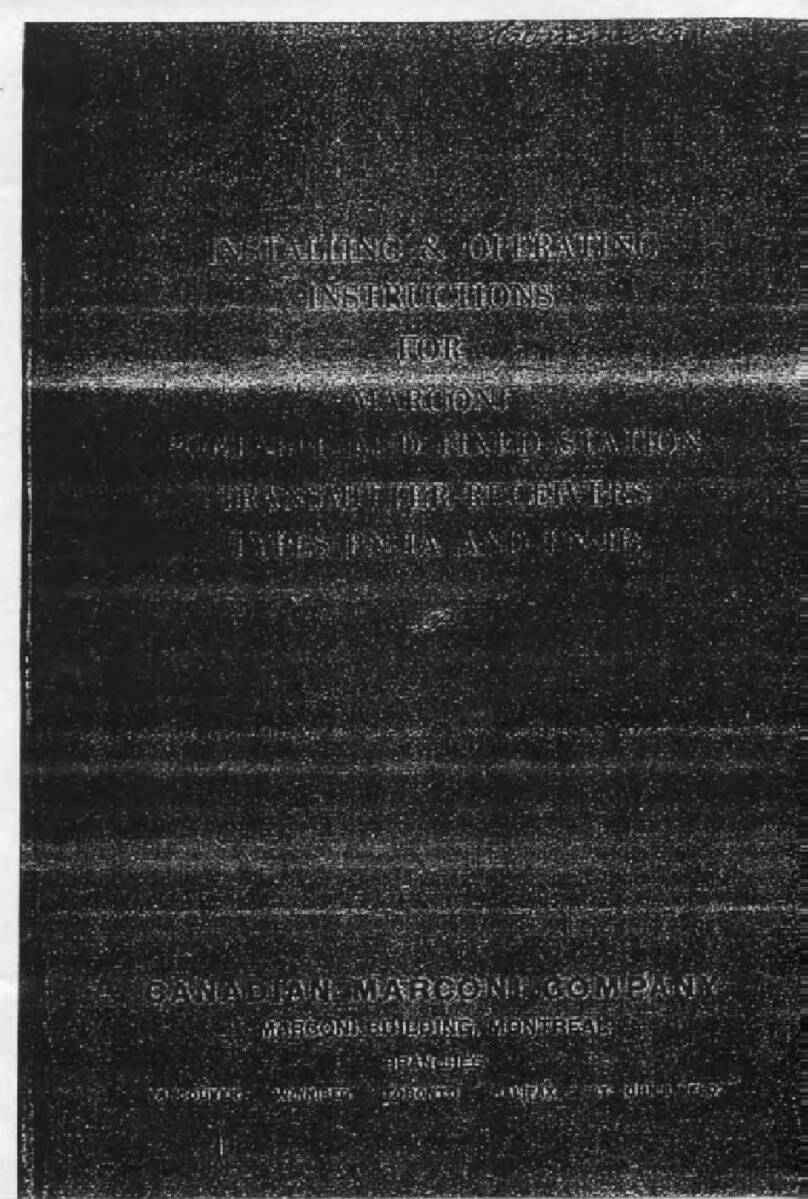
Marconi
Marconi PN1A Installing and operating instructions
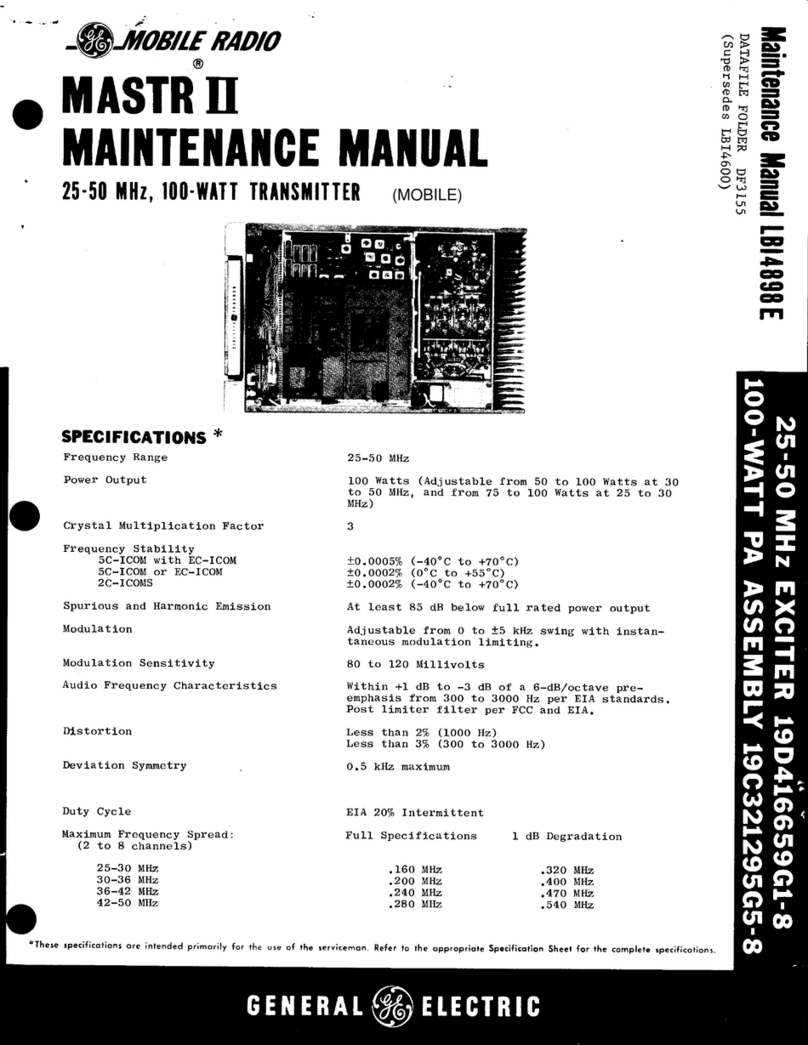
GE
GE MASTR II Maintenance manual
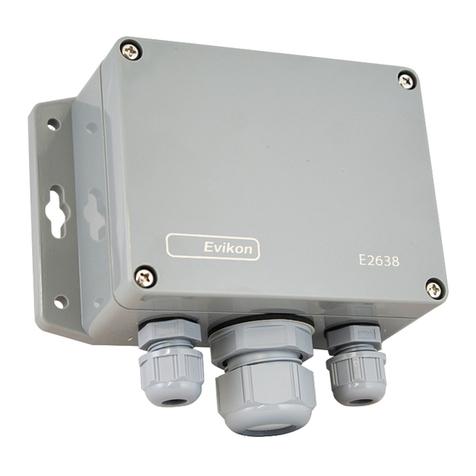
Evikon
Evikon PluraSens E2638 Series user manual
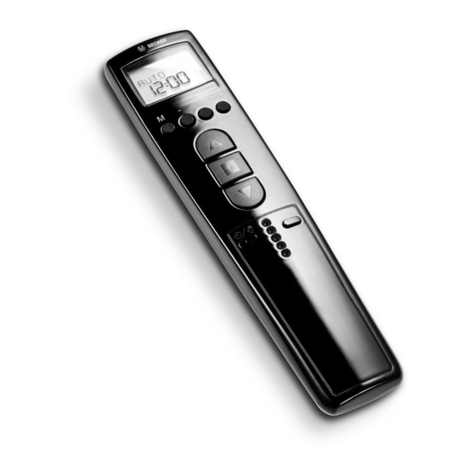
Becker
Becker Centronic TimeControl TC4410-II Assembly and operating instructions
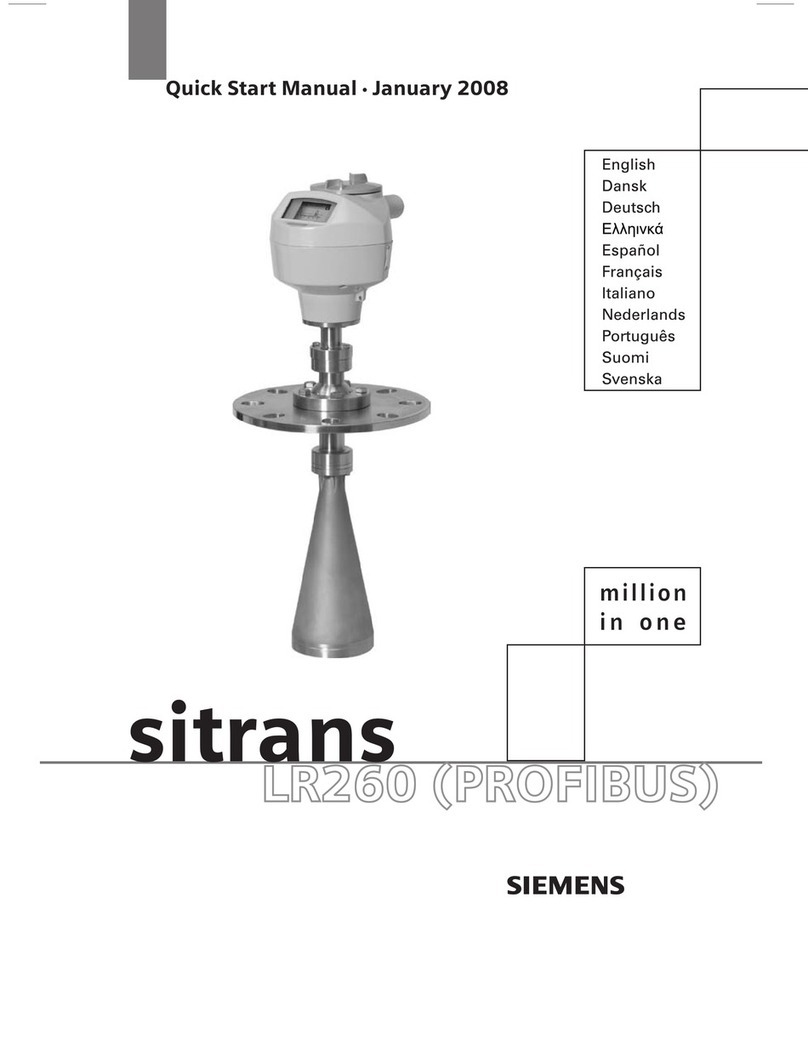
Siemens
Siemens SITRANS LR260 Quick start manual

Marti Electronics
Marti Electronics STL-10A Technical manual


